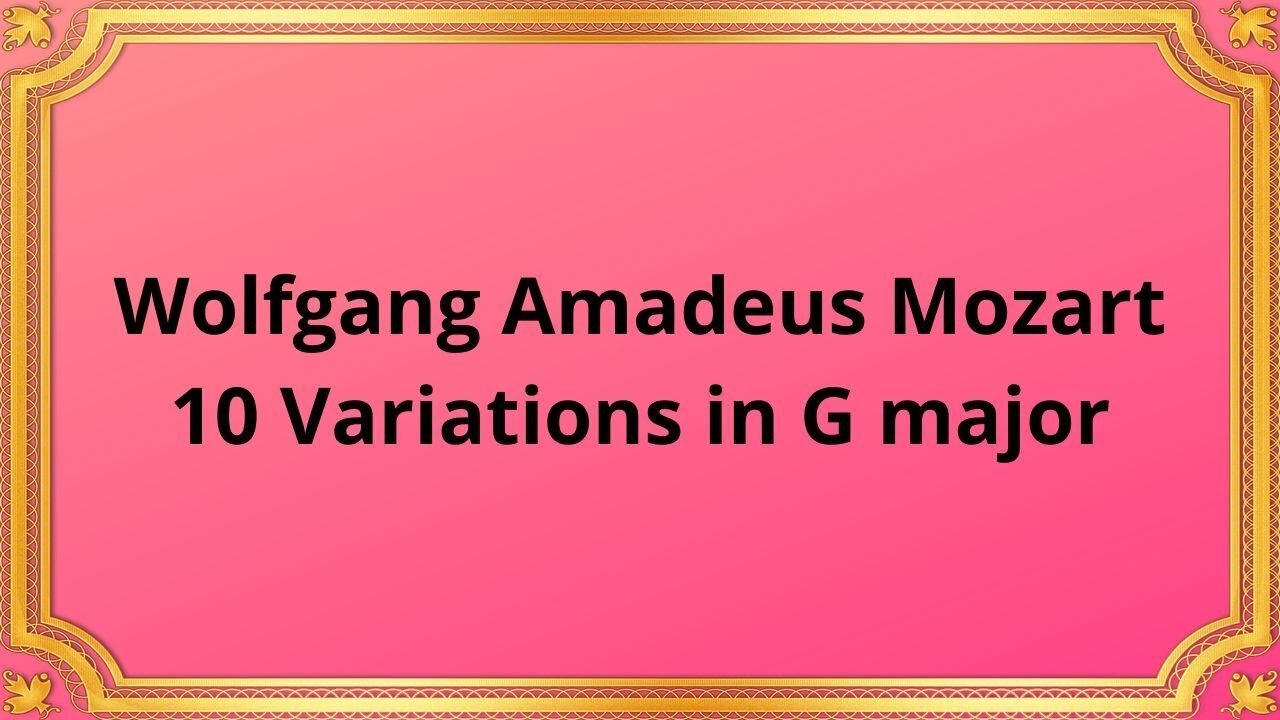Premium Only Content

Wolfgang Amadeus Mozart 10 Variations in G major
#Mozart#Chamber_music#Classical_music#Variations#Musical_composition
Publication date 1938
10 Variations in G major on ‘Unser dummer Pöbel meint’ from Gluck’s opera Die Pilgrime von Mekka K.455
Kathleen Long (piano)
Wolfgang Amadeus Mozart was a prolific composer of the classical era, famous for his symphonies, operas, and chamber music. One of his lesser-known works is the "10 Variations in G major," a set of variations for piano.
Mozart composed the "10 Variations in G major" in 1780 when he was 24 years old. The variations were written for piano and are based on a theme from a French opera by André Grétry called "Richard Coeur-de-lion." The variations were likely composed as a showpiece for Mozart's own performances.
The "10 Variations in G major" consist of a theme and ten variations. The theme is a simple, elegant melody that is presented in the opening bars of the piece. Each variation is based on this theme but features different musical elements, such as changes in harmony, rhythm, and texture.
The first variation features a lively rhythm and added ornaments, while the second variation is slower and more expressive. The third variation features a descending chromatic scale, and the fourth variation is characterized by intricate runs and trills. The fifth variation is a delicate, pensive variation, while the sixth variation is lively and playful. The seventh variation features rapid arpeggios and runs, while the eighth variation is more subdued and contemplative. The ninth variation is a virtuosic display of fast runs and arpeggios, and the final variation is a grand finale that brings the piece to a thrilling conclusion.
The "10 Variations in G major" are significant in that they showcase Mozart's virtuosic piano writing and his ability to create a wide range of musical moods and emotions within a single piece. The variations also demonstrate Mozart's skill at creating musical form and structure. Each variation is based on the same theme, but each one is distinct and unique, creating a sense of musical progression and development.
The variations are also significant in that they are an excellent example of Mozart's style. The elegance, balance, and clarity of the melodies, as well as the intricate harmonies and rhythmic interplay, are hallmarks of Mozart's music.
Conclusion
Wolfgang Amadeus Mozart's "10 Variations in G major" are a beautiful and significant work that showcases the composer's virtuosity, skill at form and structure, and unique style. The variations are a must-listen for anyone interested in classical music and are sure to delight and inspire.
-
 20:31
20:31
Classical music_Music Inspiration
1 month agoCarl Maria von Weber Clarinet Concerto No. 1 in F minor, Op. 73
471 -
 1:01:18
1:01:18
Sean Unpaved
2 hours agoTop 10 CFB QBs, Rory's Call Conundrum, & the NBA's New Age Era
17.3K -
 LIVE
LIVE
Dr Disrespect
4 hours ago🔴LIVE - DR DISRESPECT - WARZONE - NEW SEASON 4!
2,341 watching -
 43:07
43:07
Simply Bitcoin
3 hours ago $3.18 earnedMoney EXPERT Explains How $1M Bitcoin in 673 Days Happens! | EP 1255
50.1K2 -
 1:04:19
1:04:19
Timcast
2 hours agoFBI WARNS Of Copycat ASSASSINATION Threats Against Trump Over Comey's "8647"
118K73 -
 LIVE
LIVE
StoneMountain64
2 hours agoNew Downtown is HERE. MAX Battlepass Unlocked | Warzone Season 4
146 watching -
 1:57:47
1:57:47
The Charlie Kirk Show
2 hours agoWhat a Difference a Year Makes + Court Blocks Tariffs + UK Revolution | Carney, Hammer, Leo | 5.29
51.8K16 -
 14:13
14:13
Matt Kohrs
2 hours agoTrump’s Tariffs Ruled Illegal?! || The MK Show
25.4K2 -
 2:18:24
2:18:24
Steven Crowder
5 hours ago🔴 BREAKING: Court Rules Trump Tariffs Illegal - Threatens to Destroy US National Security
325K156 -
 1:40:15
1:40:15
The Mel K Show
4 hours agoMORNINGS WITH MEL K - The Conspiracy to Commit Fraud on the People of the United States of America Exposed, Time to Face the Truth of Our Betrayal 5-29-25
29.3K17